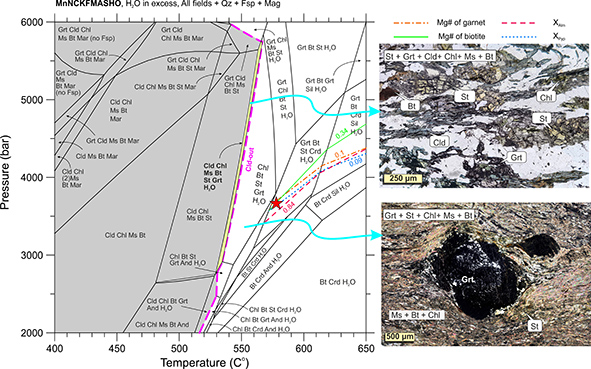Pseudosection modeling of the Precambrian meta-pelites from the Poshtuk area, NW Iran
DOI:
https://doi.org/10.13133/2239-1002/16632Keywords:
metapelites, pseudosection, chloritoid stability, Precambrain, PoshtukAbstract
Precambrian metapelites of the Poshtuk area in northwest Iran contain the prograde mineral assemblage staurolite-garnet-chloritoid-muscovite-biotite that was replaced by the assemblage garnet–staurolite–chlorite-muscovite-biotite at peak metamorphism. Whole-rock compositions of samples reveal that high Fe, Al and Mn contents of their protholite made them prone to form these assemblages. Pseudosections calculated in KFMASH, MnKFMASH, and MnNCKFMASHO systems were used to investigate the P-T evolution of the samples. They clearly show the significant effect of MnO on the stability of the chloritoid-bearing assemblages and the formation of garnet through consumption of chlorite and chloritoid. The pseudosection in a T- aH2O diagram shows that the studied assemblage could be stable only at aH2O > 0.8. XMg isopleths for garnet and biotite point to peak P-T conditions of about 3.75 kbar and 575ºC. Chloritoid is overstepped in such conditions which can be attributed to thermal perturbation due to plutonism. It is concluded, metamorphism was primarily controlled by advective heat input through magmatic intrusions in the Poshtuk area. The Precambrian basement complexes were extensively overprinted by the Pan-African Orogeny and younger igneous events which belonged to a greater Late Neoproterozoic–Early Paleozoic orogenic system that was active along the Proto-Tethyan margin of the Gondwana supercontinent.
Downloads
Published
2021-07-06
Issue
Section
PETROLOGY
License
Copyright (c) 2021 Adel Saki, Mirmohammad Miri, Roland Oberhänsli

This work is licensed under a Creative Commons Attribution 4.0 International License.

